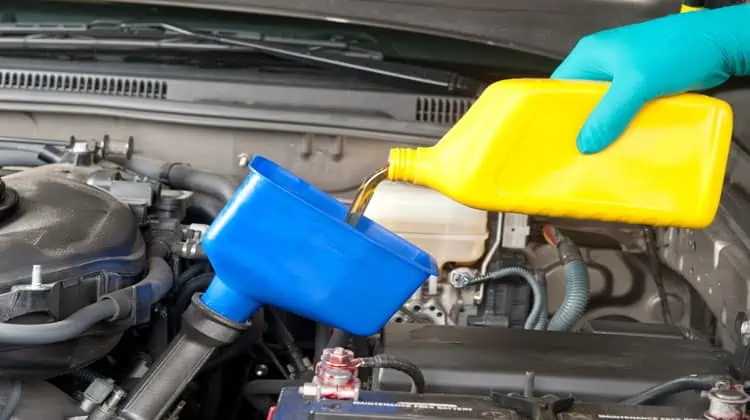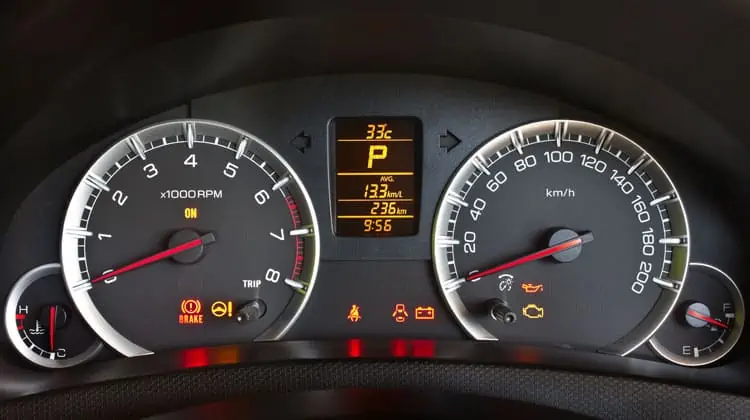THIS POST MAY CONTAIN AFFILIATE LINKS. PLEASE SEE MY DISCLOSURES. FOR MORE INFORMATION.
If you’re like most people, you probably take your car for granted.
You get in it every day and drive to work or the grocery store, without giving a second thought to how it works.
But did you know that there are a few simple things you can do to keep your car running forever?
By following the tips below, you can get 200,000 or even 300,000 miles out of your vehicle.
That could mean a savings of over $100,000 if you buy a brand new car every 100,000 miles.
The best part? It’s easy to do, so there is not reason why shouldn’t be following these tips.
21 Simple Steps To Keep Your Car Running Forever
#1. Buy A Reliable Car

If you want to make your car last forever, the first thing, and arguably the most important thing you can do is buy a reliable vehicle.
Buying a new vehicle that has a track record of lasting a long time is only going to increase the odds of it lasting a while for you as well.
It’s a lot like marriage.
You marry someone with a good head on their shoulders, who is caring and thoughtful, and isn’t afraid to deal with tough issues.
You don’t marry someone who doesn’t think things through, doesn’t care about others or themself, and is always in and out of relationships.
So what are the most reliable cars?
Historically, Toyota, Lexus, Honda have topped the list.
But in recent years, automakers like Mazda and Kia have been moving up in reliability.
When considering different makes and models, make sure you review not just the current year’s list, but also previous years as well.
You want to see a trend, not a one year assessment.
#2. Research Your Models Issues
After you find a reliable car you like, your next step is the find out the common issues it has.
Just because a vehicle has a good reliability rating doesn’t mean it is perfect.
So jump online and search for your make, model and year, along with the term forum.
There you can scan through owners posts and quickly you will see the common issues people are dealing with.
While this isn’t to stop you from buying the vehicle you want, it is helpful to know what to look out for.
For example, we bought a Chrysler Pacifica minivan.
Reading the online forums, there were issues with the transmission.
It seemed that the issue was related to the fact the minivan turned off at stop lights to improve fuel economy.
Luckily there is a button to stop this from happening, so I make sure to turn it off in hopes of avoiding this problem.
Fast forward to 70,000 miles later and I’ve avoided the issue.
#3. Get Regular Maintenance Performed
Just like you need to go to get an annual physical, you also need to take your vehicle in for regular maintenance.
This has the mechanic look over the car, trying to see if there are any issues.
It also includes replacing things like the timing belt, checking the transmission fluid level, replacing wiper blades and the air filter, and more.
The reason for all this is to prevent issues from popping up eventually.
Just like with your health, you eat right and exercise to lower the chances of developing any issues later down the road.
There is one caveat to following the manufacturer’s recommendation schedule.
If you plan on only keeping your car for 100,000 miles, following the guidelines in the owner’s manual is fine.
But if you want your car to last longer, you have to increase the service intervals.
This is because most car manufacturers consider a lifetime for a car to be around 100,000 miles.
Following the maintenance schedule in the owner’s manual will easily get you to this point.
But you could start seeing issues after this mileage.
Because of this, you want to have some services performed more frequently.
According to Dave McInsey, a mechanic for over 40 years, “you want to inspect all hoses and other things made of rubber, as these can rot. You will also want to check the exhaust system too, as over time, it can develop rust.”
#4. Have The Oil And Fluids Changed


Speaking of the maintenance schedule, you need to have the engine oil, power steering fluid, and brake fluid changed on a regular basis.
These vital fluids are what keeps everything running smoothly as they lubricate the engine, rubber seals and gaskets, and other moving parts.
So while your owner’s manual might call for an oil change every 10,000 miles, consider changing this to 5,000 miles.
Another option is to pay to get an oil analysis completed.
This test will review a sample of used engine oil and see if there is anything in it that is of concern.
It will also tell you how much life is left for the oil.
This can help you pinpoint the right time to change your engine oil without wasting money.
Just make sure you have a new test performed every 25,000 miles to ensure the schedule you are using is ideal.
Finally, while it costs more for synthetic oil, it is worth the price in the long run.
Not only does it last longer, but it works better than conventional motor oil.
The only catch to this is if you are currently driving an older car.
Because synthetic oil is thinner than traditional engine oil, you might notice leaking oil.
Because of this, a regular oil change might be a better option for an older car.
#5. Make Repairs When Needed
I know it can be tempting to put off a repair and save the cash instead, but you have to realize there is an opportunity cost to this.
This cost usually ends up being a lot more money in the long run.
For example, let’s look at a wheel alignment.
It can be tempting to save the $100 or so it would cost, but what could be the result of not doing it?
For starters, your car tires might wear unevenly.
This could lead to the suspension being thrown out of alignment and breaking or needing repair.
Your $100 preventative maintenance cost just turned into a $1,000 repair bill.
To lower the cost a little when repairs are needed, know that you don’t have to pick from genuine parts.
You can use aftermarket parts to save some cash.
Another option is to find a local junkyard.
They might have a lot of the same cars you drive and you can get the parts you need at a fraction of the cost.
The bottom line is, if you want to keep your car forever, you have to get minor repairs completed before they turn into a major repair.
#6. Pay For Decent Tires
It can be tempting to buy the cheapest set of tires when you are in need of new ones, but this is usually not the best use of your money.
You are better served with spending money for ones in between the cheapest and most expensive.
And before you buy new tires, go online and read user reviews.
These can give you insights into what people like and dislike about a particular tire.
You should also check out the mileage warranty as well.
A more expensive tire that has a tread life of 80,000 miles is going to cost you less over the long term than a cheaper tire with a 20,000 mile tread life.
Finally, to help you lower your costs more, make sure you regularly check the air pressure.
When you keep your car tires at the proper psi, it extends the life of them.
Over inflating or under inflating can wear the tread out much faster.
If you don’t want to regularly check your tire pressure, consider using nitrogen instead.
It isn’t impacted by the changing temperatures like air is.
And here is a bonus tip that I use to save money on tires: wait for sales. You usually can get a deal of paying for three tires and getting one free.
Or, if you belong to a warehouse club, you might get free installation as well as a gift card.
The bottom line is, don’t wait until your mechanic says it’s time to replace your tires, proactively look for deals when you know your tires are nearing their end of life.
#7. Drive Your Car
Many car owners think that not driving their vehicles is sure way to keep their car running forever.
But this is not true at all.
If you never drive your car, the rubber seals and gaskets will rot, rodents will nest in the engine bay, the fluids in the car will go bad, and other components could begin to fail.
Plus the tires will develop flat spots as the tire pressure drops.
And this is just some of the things that will happen.
All told, it will cost you a lot of cash to get your car back on the road.
So instead of letting it sit idle for months or years, make it a point to drive it a couple times a month for 20-30 minutes.
This will keep it in good condition and avoid many of the expenses listed above.
#8. Try To Drive On The Highway


Speaking of driving, if at all possible, try to drive mostly highway miles.
This will save you a lot of money in the long run and help it last.
There are a few reasons for this.
First, by driving at highway speeds, your transmission will not be shifting gears all the time.
This lowers the wear and tear on this part.
You also won’t be braking often, saving you on the cost of needing to replace brake pads.
Finally, highway driving is the most fuel efficient driving style, so you will be getting better gas mileage, saving you from more frequent fill ups at the gas station.
If you live in an area that offers public transportation, do your best to take advantage of this to limit city driving.
Or see if you can walk or bike more often as well.
#9. Use The Engine To Slow Down
New brakes can cost a lot.
To help lower the cost and make the brake pads you have now last longer, use the engine to help slow you down.
This is done by simply taking your foot off the gas well before you are coming to a stop and letting your car slow down naturally.
If you drive manual transmission cars, you can keep it in a lower gear, which will do the same thing.
However, if you drive a hybrid, you want to use the brakes as this is what regenerates power for the battery.
#10. Don’t Abuse Your Car
Most car owners drive like they are in the Indianapolis 500.
While it can be fun at times to drive fast, know that the harder you drive, the more wear and tear you put on the car.
Learn to accelerate from a stop slowly, not revving the engine.
As mention above, anticipate stops and slow down earlier rather than slamming on the brakes.
The more you can use a calm driving style, the better off you will be.
#11. Pay Attention When Driving
When you are out on the road, you need to pay attention to what is happening around you.
By keeping your eyes on the road, you can spot potholes and other debris in road that you can safely avoid.
You can also see a traffic jam or accident up ahead and prepare to slow down now.
Coupled with the point above, these will help keep your vehicle running forever and save you in repair costs.
They will also help you be a safer driver, which can lower your auto insurance premium too.
Also, make it a point to listen to your car.
When you do this, you will notice any odd noises that could be a sign of trouble.
Finally, in between the times you visit your mechanic, lift up the hood and inspect the engine bay.
See if you need your fluids topped off or if the air filter is unusually dirty and needs replacing.
#12. Use The Air Conditioner
Many people look to not use the air conditioner to save cash.
But if you never use it, the same thing happens as above when you never drive your car.
The air conditioning system needs to run from time to time to stop it from deteriorating and limit the loss of refrigerant.
So make it a point to run this system from time to time to ensure it lasts.
#13. Take It Easy On A Cold Engine
Modern cars built today are able to be turned on and driven.
This is the opposite of cars from years ago that needed to be warmed up in order for you to drive it.
But this doesn’t mean you can start your car and race off.
You should take it easy until your car reaches its normal operating temperature.
Again, this isn’t saying you have to sit and idle for 20 minutes, but rather drive slowly as it warms up.
#14. Understand Your Gauges


Do you know what all your gauges measure?
Many people ignore their instrument cluster until warning lights come on.
In some cases, this is too late and you now have a costly repair.
Instead, familiarize yourself with the various gauges on your dash.
Know what they measure and what is normal for your car.
Then make it a point to check them every once on a while.
Ideally when you first start your vehicle and then again in the middle of drive.
If you notice anything higher or lower than usual, take your car in to your mechanic and make sure everything is OK.
It will be a lot less expensive to catch something early and fix it than waiting until it turns into something bigger.
#15. Keep Gas In Your Tank
Are you someone that waits until the last possible moment to fill your gas tank?
Do you try to get the very last drop out before you refill?
If you answered yes, you could be doing major damage without realizing it.
Letting your tank get close to empty makes the fuel pump work harder, which will cost you when you have to replace it.
Second, when you fill your tank, there is some sediment from the underground storage tank that can get into your gas tank.
Keeping an ample supply of gas in your tank keeps this sediment on the bottom where it is harmless.
But when your gas level drops, you can introduce some of this into your fuel lines and cause havoc.
So make sure you fill up whenever your tank gets three quarters empty.
#16. Stop Using Your Car For Storage
If you store heavy objects in your car, you are decreasing the life of parts of your car.
Aside from more weight decreasing fuel economy, the extra weight puts pressure on your tires and suspension system.
Replacing these items can cost a pretty penny.
So stop using your car as a storage unit and spend a few hours cleaning it out.
In fact, you can wash and wax it at the same time.
#17. Wash And Wax
It is important to wash and wax your car regularly.
Many people just think about the engine bay but the exterior needs loving too if you want your car run forever.
Washing, especially the undercarriage will help to remove road salt which can lead to rust on the frame.
Trust me, you do not want to have rust on your cars frame.
While you could pay to prevent rust using a sealant, simply washing regularly should be enough.
Washing also keeps the paint in good condition as the sun and other things like tree sap, pollen, and bird droppings, can destroy it.
And this is where waxing comes in.
Waxing further protects the paint.
If you ever saw a freshly waxed car get wet you know it.
The water beads and slides right off, protecting the paint.
You can even run your hand over a dry car with new wax.
It will feel slippery.
Washing should be done monthly and waxing at least twice a year.
Finally, don’t overlook the interior of your car too.
Vacuum the seats and floor mats, as well as wipe down the dash and interior windshield.
You might even consider buying rubber floor mats as opposed to using the fabric mats as they will protect your floor much better from rain and melting snow.
#18. Garage If Possible


It is ideal if you can park your vehicle in a garage.
Not only will this protect it from the rain and snow, but also the sun.
All of the elements wear down the exterior of your vehicle.
The more you can keep it in the shade in a garage, the better.
Even if you can only use a car port, this is better than nothing.
Finally, think twice before investing in a car cover.
Many of the lower priced ones will actually do more harm than good.
#19. Find An Honest Mechanic
It is critical you find an honest mechanic at a local garage you can trust.
When you have someone like this, you won’t think twice about taking your vehicle in to get a tune up or even just checked out for odd noises.
While they can be hard to find, putting in the work to find one will pay off for many years to come.
#20. Skip The Infomercials
It can be tempting to fall for the late night infomercials that claim higher gas mileage, or better performance.
The reality is these items don’t offer as great of a benefit as they claim, if any benefit at all.
You have to remember that many manufacturers are fighting each other to get you to buy their vehicle.
If there really was a simple $20 gizmo that can add 20mpg to your vehicle, chances are the manufacturer would have it already.
They would love to easily boost their fuel economy compared to their competitors.
The bottom line here is, you are better off changing the channel than you are get sucked into buying something that costs more than it is worth.
#21. Know When To Call It Quits
Finally, as much as you want your car to run forever, it isn’t always possible.
In some cases, you follow all these tips and it’s still not enough.
You have to be able to do the math and know when to sell your car.
If it is costing you more and more every year in repairs, and the costs are in the thousands of dollars, buying another vehicle might make more sense.
This doesn’t mean you need to buy a new car or even have a car payment either.
There is a great trick I teach others so they never have a car payment again.
Final Thoughts
There are the steps to follow if you want to keep your car running forever.
If you follow these tips, and modify the maintenance schedule, you will greatly increase your odds of reaching very many miles.
Just make sure you are putting the savings into a fund to help you get ahead financially or towards buying your next vehicle.
I have over 15 years experience in the financial services industry and 20 years investing in the stock market. I have both my undergrad and graduate degrees in Finance, and am FINRA Series 65 licensed and have a Certificate in Financial Planning.
Visit my About Me page to learn more about me and why I am your trusted personal finance expert.
Read the full article here














